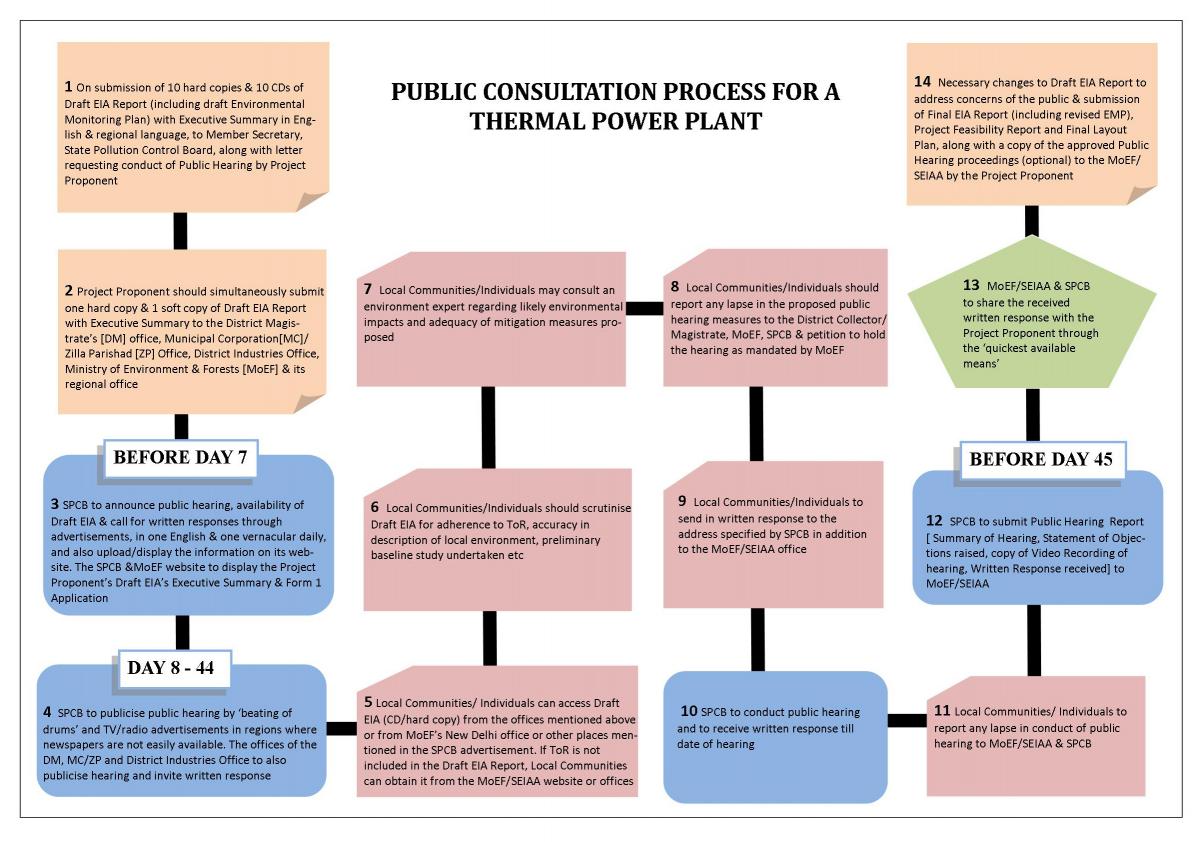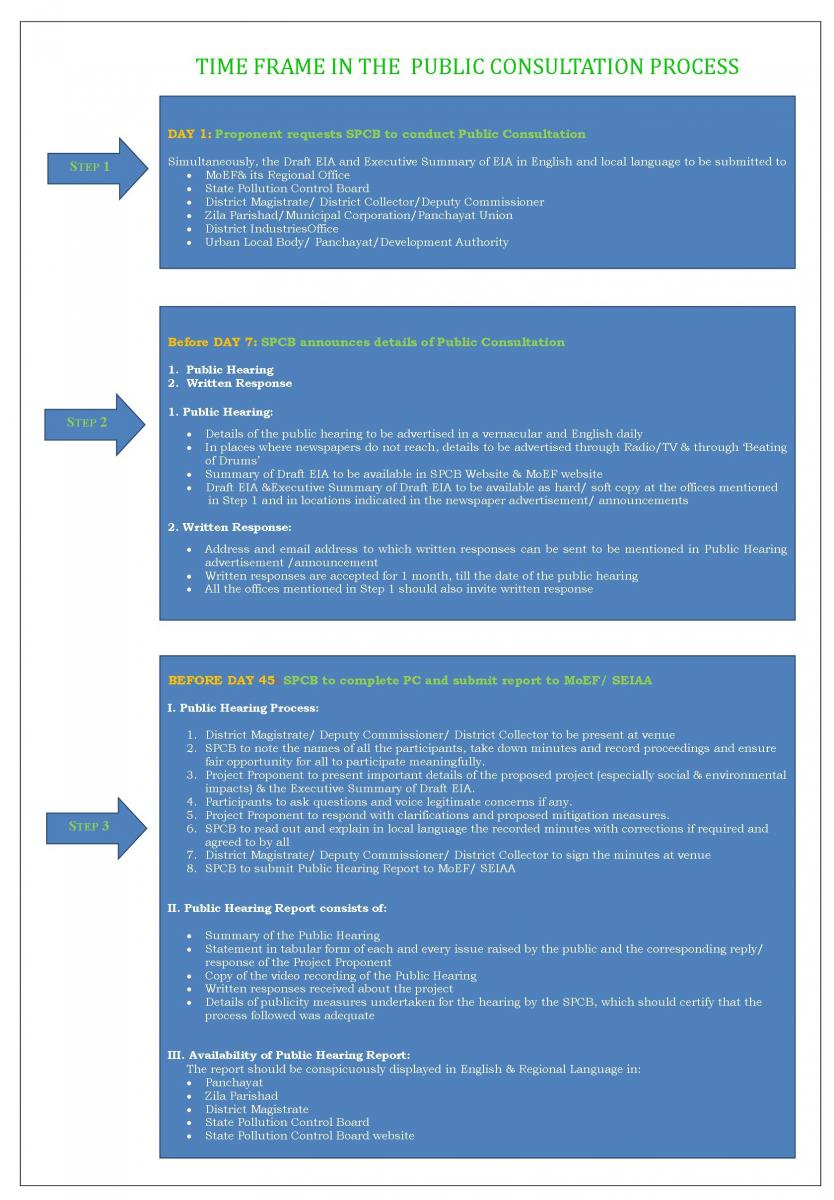- Public Consultation Process in a nutshell
- Structure & intent of Public Consultation
- FAQs (Frequently Asked Questions)
Public Consultation Process in a nutshell
Public Consultation (PC) is currently the best opportunity and the biggest platform available, for local communities and for all those with a stake in the environment of the region in which a TPP is being proposed, to get queries clarified and to express concerns and record their opposition to the project, if it legitimately impacts their rights. The outcome of the public consultation process depends both on the number of participants and on effective participation by the public. The queries, concerns and protests of the public are to be noted and, if found correct, may be used by the Regulatory Authorities to reject the application.
The PC is conducted after the Project Proponent/Applicant submits the draft EIA to the MoEF or SEIAA and simultaneously submits a letter to the relevant SPCB to conduct the PC.
Within 45 days of receiving the letter, the SPCB must complete the PC process and submit a report to the MoEF/SEIAA. If the SPCB does not complete the PC process within the time frame, the MoEF/SEIAA can appoint another agency to conduct the hearing.
The Project Proponent/Applicant must take these viewpoints into consideration and revise the draft EIA accordingly. The grant of EC/rejection of application by the Regulatory Authority will be based on the Final EIA submitted.
The Public Consultation is in two parts:
- Public Hearing: This is a mandatory meeting conducted by government officials for all TPPs, irrespective of their capacity & location. Here, the Project Proponent/Applicant explains the project to the people present. It is the forum for the people to individually and collectively query and voice apprehensions/concerns about the project. The proceedings are to be recorded by the officials.
- Written Response: Members of the public can also send in writing their queries and concerns about the project to the SPCB and the Regulatory Authority
Structure and Intent of PC
PUBLICITY
Advertisements announcing the Public Consultation (Public Hearing and Written Response) should be clear and appropriate.
Advertisements should be placed in one English daily and one Regional Language Daily in circulation in that district.
PUBLIC HEARING
Notice period
The SPCB has to give at least one month’s notice to the public about an upcoming hearing.
Venue
- The venue for the public hearing should be close to the project site. A National Green Tribunal (NGT) Order says that as far as possible, the hearing venue should be within 1 km of the project site. (Krishi Vigyan Arogya Sanstha & Anr Vs MoEF & Ors)
- The venue chosen should be the closest available one to the project site.[1] For example, if there is a suitable venue two kilometres from the site, the SPCB cannot choose another venue which is further away
- If the venue is not close to the project site, the Project Proponent has to arrange to transport the public to the venue. Even if the Project Proponent is organising transport, the public hearing cannot be held too far away.[2]
Mandatory presence of Government Officials
- District Magistrate / District Collector/ Deputy Commissioner or their representatives not below the rank of an Additional District Magistrate
- Representative/s of the SPCB
Public Participation
- Local communities and members of the public wishing to participate.
- No quorum for attendance required.
- Presence of all those at the venue should be noted.
- Public should have access to the dais in case they wish to approach the officials present. (The dais area cannot be cordoned off).
Recording of proceedings
The SPCB should make arrangements for the public hearing to be video graphed.
SPCB officials to accurately record the minutes of meeting.
Complaints
Any erroneous or changed fact about the project or its impact in the documents presented ahead of the hearing or in the minutes recorded and read out at the hearing can be reported by the public to the officials present at the public hearing.
Any procedural lapses in the conduct of the public hearing can be reported to the MoEF/ SEIAA along with a demand for a fresh hearing.
Written Response
During the one month notice period given for the public hearing, written responses from the public will be received by the SPCB.
The e-mail and postal address for receipt of written response should be advertised in the SPCB’s Public Consultation advertisement. These responses are collated by the SPCB and included in the Public Consultation Report submitted to the MoEF/SEIAA.
The MoEF/SEIAA should reach the responses received as part of the Public Consultation process to the Project Proponent/Applicant through the ‘quickest available means’. The written responses received will be part of the Public Hearing Report submitted by the SPCB, and should be available in the offices of the Panchayat, Zila Parishad, District Magistrate and the SPCB, apart from the SPCB website.
FAQs (Frequently Asked Questions)
1. Can I attend the Public Hearing and also send in a Written Response?
Yes, you can.
2. I am not residing near the proposed project site - can I still participate at a Public Hearing and voice my concerns?
Yes, you can, as long as you have valid social and environmental concerns to make!
3. I don’t have a core environmental issue to be raised in Public Hearing meeting. Instead, I want to raise queries about social and employment-related issues. Can I do it?
Yes, the public hearing is intended to focus on the environmental impacts of a proposed project. However, the word ‘environment’ is to be interpreted broadly and issues concerning social as well as economic (including livelihood) impacts are part of EIA studies. They can, therefore, be raised during public hearings. Social Impact Assessment and Rehabilitation and Resettlement Plan are part of EIA studies and issues concerning these can be raised during the hearing.
4. Who can send Written Responses about a project?
Anybody who has a plausible stake in the environmental aspects of the project or activity, like activists and media personnel, apart from local communities, can send in written responses.
5. What should be done if a project has been awarded EC without holding a Public Hearing?
A petition has to be filed against the EC at the National Green Tribunal. This has to be done within 30 days of the communication of EC, extendable to 90 days if there is a justifiable reason.
6. Can the Public Hearing of two projects be held simultaneously at same time and same venue?
No, this is not allowed, as per an Office Memorandum issued by the MOEF in April 2010[3].
7. Can a Public Hearing be postponed?
Yes, but only when there is an emergency. Otherwise, the public hearing date, time and venue cannot be changed.
- A hearing can be postponed only on the recommendation of the District Magistrate/District Collector /Deputy Commissioner.
- The postponement should then be announced through advertisements in the same English and regional language daily that the scheduled hearing was announced. It should also be prominently displayed at all offices identified by the SPCB.
- The fresh date, time and venue for public consultation should then be decided by the Member-Secretary of SPCB only in consultation with the District Magistrate/District Collector/Deputy Commissioner and notified afresh.
- Due to a local situation, if the public hearing cannot be held in the stipulated manner, the SPCB will then report it to the MoEF/ SEIAA which may, after due consideration, decide that the public consultation in that particular case need not include the public hearing.
- However, a recent NGT order has said that in a situation where the people are aggressive and agitated, the public hearing should be cancelled and held later in order to ensure that proper representation is made
8. Can the people demand postponement of the public hearing?
Yes, but only if there have been any procedural lapses in conducting the hearing - like the venue being too far or the Draft EIA not available in notified places. The people can make a joint representation to the District Magistrate/ Collector or Deputy Commissioner.
9. Is there a regulation on how many people can talk at a public hearing?
No, there is no limit! All those who are present at the hearing should be given an opportunity to voice their views.
10. Is there a fixed time limit for the public hearing?
No! As long as there are public queries to be answered, the hearing should continue.
11. A project has been proposed in a highly polluted area. Can I then ask about the total impact of all the polluting projects in a public hearing for one project?
Yes, you can! The EIA study includes an assessment of the cumulative impact of projects- proposed and upcoming- in the project area. Issues related to the Cumulative Impact of these projects should be allowed in a public hearing.
12. If the project site is in the boundary of two states, where should the public hearing be held?
In such a case, the hearing should be jointly organised for both the states by the respective SPCBs.
13. Is there a way to find how the SPCB publicised a public hearing?
Yes! This information should be available in the Public Hearing Report. An Office Memorandum issued by the MoEF in April 2010 requires the SPCB to mention in the Public Hearing Proceedings how adequate measures were taken to inform the local people about the hearing time, venue and date. The SPCB should also certify that the process followed for the hearing was adequate. [4]




